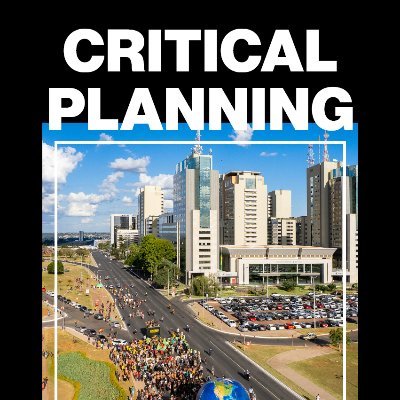
Critical Planning Journal
@CritPlanning
Followers
522
Following
132
Media
12
Statuses
228
Critical Planning Journal is the journal of the UCLA Urban Planning Department, committed to elevating criticality and advancing social justice.
Los Angeles, CA
Joined October 2013
Critical Planning Journal is pleased to announce our call for submissions to Volume 28: Margins and Junctures. Submissions are due October 31, 2024. For more information and submission instructions visit our website: https://t.co/UHwLzuKEAx.
0
10
17
We would love to see you at the event that the Critical Planning Journal is presenting on improving landlord practices and bolstering tenant protections at the Skid Row History Museum & Archive on Nov. 12. All are welcome!
0
3
6
DEADLINE EXTENDED 📢 Submissions for Critical Planning Journal's next volume, Vol. 28: Margins and Junctures, are now due Nov. 15, 2024.
0
2
4
Critical Planning Journal is pleased to announce our call for submissions to Volume 28: Margins and Junctures. Submissions are due October 31, 2024. For more information and submission instructions visit our website: https://t.co/UHwLzuKEAx.
0
10
17
Reminder that submissions to Critical Planning Journal Vol. 28: Margins and Junctures are due October 31, 2024. Graduate student submissions are especially welcome! For more information and submission instructions visit our website: https://t.co/UHwLzuKEAx.
0
3
2
The historic student protests continue. Yesterday at UCLA, our students maintained peace & purpose, ignoring incitement by counter protesters. Inside the liberated zone, there were study circles, music, camaraderie, art-making & more. Our students have become our teachers.
0
99
412
5/6 of formats and to offer support and guidance to emerging scholars, activists, and artists. These efforts come to life in volume 27, which contains articles, commentaries, poems, photo essays, and other artistic outputs from a diverse set of contributors, who together explore
1
0
0
4/6 publication, we considered how Critical Planning could amplify voices and perspectives underrepresented in conventional urban planning discourse. Building on the journal’s history of student-led creative inquiry, we endeavored to attract and publish contributions in a range
1
0
0
3/6 in the city. Embracing all the potentiality and pitfalls of this theme, the editorial committee also interrogated how the journal’s own administrative structure and operations might themselves become more open. From the call for submissions to the review process to
1
0
0
2/6 the pleasures of life lived among multipli/cities” (Friedmann 2002). From data points to migration patterns, “open” vocabularies are often employed in social movements and across urban planning efforts to express a range of democratic principles in pursuit of social justice
1
0
0
1/6 Openness is an enduring urban ideal. The open city has long been associated with difference, freedom, creativity, and collaboration, as “a city that is life affirming, that reaches out to others who are not necessarily like us, and that acknowledges our common humanity and
1
0
0
Volume 27: “Open” is now published and accessible via our eScholarship page: https://t.co/t4AZSW3Xoz Volume description below ⬇️ #criticalplanning #critplan #urbanplanning #urban #cities #urbanism #urbanist #ucla #luskin @uclaurbnplnning @UCLALuskin
1
3
4
5/6 of formats and to offer support and guidance to emerging scholars, activists, and artists. These efforts come to life in volume 27, which contains articles, commentaries, poems, photo essays, and other artistic outputs from a diverse set of contributors, who together explore
1
0
0
4/6 publication, we considered how Critical Planning could amplify voices and perspectives underrepresented in conventional urban planning discourse. Building on the journal’s history of student-led creative inquiry, we endeavored to attract and publish contributions in a range
1
0
0
3/6 in the city. Embracing all the potentiality and pitfalls of this theme, the editorial committee also interrogated how the journal’s own administrative structure and operations might themselves become more open. From the call for submissions to the review process to
1
0
0
2/6 the pleasures of life lived among multipli/cities” (Friedmann 2002). From data points to migration patterns, “open” vocabularies are often employed in social movements and across urban planning efforts to express a range of democratic principles in pursuit of social justice
1
0
0
1/6 Openness is an enduring urban ideal. The open city has long been associated with difference, freedom, creativity, and collaboration, as “a city that is life affirming, that reaches out to others who are not necessarily like us, and that acknowledges our common humanity and
1
0
0

